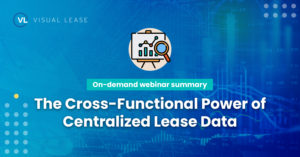
On-demand webinar summary
Having accurate, reliable lease data is a necessary part of achieving lease accounting compliance. But beyond lease accounting, having visibility into lease data also supports businesses manage lease-related expenses and avoid potential overpayment.
In our recent webinar, The cross-functional power of centralized lease data, lease accounting experts (Joe Fitzgerald, SVP of Lease Market Strategy at Visual Lease, Zachary Forrest, Executive Director at Jackson Cross Partners, and Lou Battagliese, SIOR and Founding Partner at Jackson Cross Partners), covered how centralized lease data can unlock cross-functional business opportunities.
About Visual Lease
Visual Lease makes easy-to-use software to help organizations manage and account for their leases, and stay compliant with US-GAAP, IFRS and GASB lease accounting standards.
About Jackson Cross Partners
Jackson Cross Partners is a full-service corporate real estate company, providing services to support companies in every stage of their real estate maturity.
Here are some key takeaways from the webinar:
Today, businesses have more visibility into their leases
The new lease accounting standards require businesses to pay closer attention to their leases. To comply, they have developed cross-departmental processes to identify and keep track of each lease within their portfolio.
“It’s really important to be able to know what your rights and obligations are within your lease portfolio. Do you have an option to renew a contract or expand? Is there a termination option? If you’re forced to read leases while doing this analysis, you’re going to be behind the curve.” – Lou Battagliese, SIOR & Founding Partner, Jackson Cross Partners
Centralizing lease data in one location is an effective way to ensure each lease is represented – and provides businesses with a useful view of their leases. In turn, businesses can use this data to make better informed decisions, saving them time and money that may be otherwise left on the table.
How did we get here?
When businesses began preparing for the new lease accounting standards, they quickly realized how time-consuming it was to gather leases. It required accounting teams to work cross-functionally with departments such as legal, real estate, procurement and human resources. However, as the transition date loomed, accounting teams panicked and took over the project.
“It became a phase one project just to get the lease accounting in. Some companies also found alternative solutions and now these companies have multiple systems of truth [for their leases].” – Lou Battagliese, SIOR & Founding Partner, Jackson Cross Partners
Then, once the pandemic hit, businesses were forced to adapt to hybrid or work-from-home arrangements, which created even more challenges for how cross-departmental teams worked together to gather and organize lease data.
The ongoing effects of the pandemic also impacted office space utilization, industrial supply chain demands and retail storefront footprints. Now more than ever, businesses rely on having their lease data in a centralized location, so they can make better, more informed decisions about their leases.
How centralized lease data impacts businesses
Having centralized lease data enables your business to easily lean into lease terms and uncover opportunities to potentially reduce lease costs.
Lease data is incredibly powerful to use within:
- Cross-functional workflows that encourage collaboration
- Operational efficiencies with complete and accurate lease data
- Timely, strategic decisions to efficiently react to economic changes
- Cost-saving opportunities with Day 2 and beyond
To learn how to empower your business with centralized lease data, view our on-demand webinar: The cross-functional power of centralized lease data.
Visual Lease and Jackson Cross Partners provide a full end-to-end solution for ASC 842, IFRS 16, GASB 87 and GASB 96. Click here to download our one-pager for more information.























